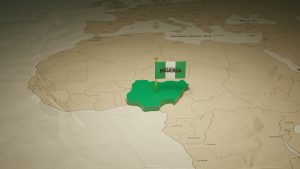The Nigerian economy appears to be delicately poised in 2025. Having initiated significant economic reforms in 2023, aimed at addressing long-standing structural challenges and revitalising the economy, the current administration is confronted with outcomes that are, at best, well below expectations. The key policy reforms, including the removal of petrol subsidies and the liberalisation of the foreign exchange market, have left the embattled average Nigerian with a growing sense of disillusion. Persistent naira weakness and elevated price levels, particularly for food and fuel, continue to erode real incomes, exacerbating the already severe cost-of-living crisis. The significant depreciation of the naira in 2024, by 41.4%, has also relegated Nigeria to fourth place on the list of African countries by economic size, with a GDP of $199.72 billion, trailing South Africa ($403.5 billion), Egypt ($380.04 billion) and Algeria ($260.13 billion).
Social intervention programs have yielded minimal tangible results, offering little relief to the populace amidst rising economic pressures. For many analysts, the delayed execution of the 150-day duty-free import window – intended to curb soaring prices of essential staples such as maize, rice, wheat and cowpeas, and originally slated to begin on July 15, 2024 – is asymptomatic of the unfulfilled policy commitments that have increasingly characterised the current administration’s governance approach.
Wary of mounting public discontent, the government appears caught in a dilemma of needing to pursue further critical reforms while grappling with the immediate economic hardships stemming from prior policy changes. Despite the adverse short-term effects, we maintain that sustaining and accelerating the reform momentum is essential for long-term economic stability. However, the prevailing “short-term pain for long-term gain” narrative is increasingly met with scepticism, as questions arise regarding the true duration of this so-called short-term period and the extent of the average Nigerian’s capacity to endure heightened economic strain. Without clear communication and tangible signs of improvement, the risk of reform fatigue looms large.
GDP Growth: Boosting Output, Building Momentum
We believe that Nigeria’s near-term economic outlook hinges significantly on the ability to ramp up crude oil production to meet its OPEC+ quota of 1.5 million barrels per day (mbpd). Attaining this target is essential for boosting government revenue, alleviating fiscal pressures and fostering exchange rate stability. However, achieving and potentially surpassing this threshold will require sustained efforts to consolidate the progress made in 2024, when crude oil production increased by 8% to an average of 1.42 mbpd, largely due to improved security measures and a reduction in crude oil theft and vandalism. We expect this positive trend to continue in 2025, projecting a potential increase to an average of 1.48 mbpd under a best-case scenario. Nevertheless, this remains 28.2% below the overly optimistic 2.06 mbpd production assumption in Nigeria’s 2025 expenditure framework. Increased operational efficiency, driven by the Nigerian Upstream Petroleum Regulatory Commission’s (NUPRC) Advance Cargo Declaration regime – designed to uniquely track and validate all exported crude oil and gas cargoes – will be critical in curbing oil theft and ensuring the integrity of export documentation. In addition, the Nigerian National Petroleum Corporation’s (NNPC) plans to replace aging crude oil pipelines could further support efforts to sustain and enhance production levels.
While manufacturers will contend with high interest rates and subdued consumer demand, we expect improvements in crude oil production to support foreign exchange (FX) supply and sustain the exchange rate stability, which is also positive for trade and other import-dependent activities. Crucially, we expect domestic crude oil refining to provide a significant boost to Nigeria’s GDP growth momentum following the partial re-commencement of operations at the Port Harcourt (60,000 bpd) and Warri (125,000 bpd) oil refineries. These, in addition to the 650,000 bpd Dangote Refinery and other oil refinery projects across the country are projected to raise Nigeria’s total oil refining capacity to over 1.2 mbpd in 2025. This development signals a potential end to refined petroleum imports by late 2025, a critical milestone in managing foreign exchange pressures. Furthermore, in the medium term, surplus refined products could position Nigeria as a key regional supplier, enhancing export earnings and improving the trade balance. Food output is anticipated to improve, supported by military assistance to farmers in some parts of Nigeria’s food-producing regions and a significantly weaker naira, which is driving increased exports to neighbouring countries. On the basis of the aforementioned, we expect GDP growth to hover between 3 to 4.0% (base case scenario) in 2025 as inflation peaks and begins to decline followed by the possible easing of monetary conditions by year-end.
We commend the ongoing efforts to rebase Nigeria’s GDP, as updating the base year from 2010 to 2019 is a necessary step toward accurately capturing the nation’s evolving economic structure and performance. This exercise is particularly significant as it will incorporate the contributions of previously underrepresented sectors, including the informal economy, thereby providing a more comprehensive reflection of economic activity. A rebased GDP will enhance the precision of key economic indicators, offering policymakers and investors more reliable data to guide strategic decision-making and policy formulation.

Inflation: Price Pressures to Abate
In 2024, Nigeria’s headline inflation rate largely continued on its upward trajectory, rising steadily to close the year at a 28-year high of 34.8%. This was largely driven by a spike in food prices, with food inflation soaring to an all-time high of 40.87% in June 2024, driven by persistent insecurity, including farmer-herder clashes and kidnappings for ransom in key agricultural regions. The impact of this was worsened by higher logistics costs following the spike in diesel and petrol prices. What initially seemed like a potential inflection point in mid-2024, following successive months of decelerating inflation, to 33.4% in July and 32.15% in August, proved short-lived. Renewed inflationary pressures were triggered by continued naira weakness and the complete removal of petrol subsidies, which raised prices by 36% to ₦950-₦1,019 per litre), sparking another wave of inflationary pressures.

We anticipate elevated inflationary pressures persisting through the first half of 2025. However, we project a gradual deceleration of price pressures commencing in the third quarter (Q3 2025), primarily driven by base effects. By year-end, we expect inflation to moderate to an average of 30%, supported by sustained monetary tightening, a relatively more stable naira than in 2024 and expectations of higher food output given the military support to farmers in some parts of the country’s food-producing regions.
While heightened competition among domestic oil refiners is driving down pump prices – a positive development for Nigeria’s inflation outlook – we remain cognisant of external risks, particularly the potential resurgence of U.S. oil production driven by Trump-era energy policies. This development presents a double-edged sword for Nigeria. On one hand, lower global oil prices could reduce petrol costs, helping to ease inflationary pressures. On the other hand, diminished oil revenues could strain Nigeria’s foreign exchange reserves, potentially triggering renewed naira volatility and depreciation. This, in turn, would increase the cost of crude oil feedstock for domestic refineries, ultimately exerting upward pressure on fuel prices. As such, while short-term inflation relief is possible, long-term stability will depend on the Federal Government of Nigeria’s (FGN) ability to manage both domestic and external shocks effectively.

Monetary Policy: Steering Monetary Stability
In stark contrast to the prevailing trend in advanced economies where central banks commenced interest rate cuts following the aggressive tightening cycles of 2022 and 2023, the Central Bank of Nigeria (CBN) maintained a resolute focus on combating inflation. This led to a cumulative increase in the Monetary Policy Rate (MPR) of 875 basis points throughout 2024, culminating in an all-time high of 27.5%. The CBN acknowledges the detrimental impact of high interest rates on the real sector, emphasising the critical need for coordinated monetary and fiscal policies. While Governor Olayemi Cardoso has hinted at a potential shift towards a more accommodative monetary stance to support broader economic reforms, the marginal rate hike in November 2024 (of 25 basis points) was perceived by many analysts as a potential inflection point, signifying a possible deceleration of the aggressive tightening cycle initiated in 2022.
Despite this observation, we anticipate the CBN to maintain a relatively stable interest rate environment throughout the majority of 2025. A gradual reduction in interest rates is considered probable, contingent upon sustained deceleration in inflation and a marked improvement in exchange rate stability. Based on this analysis, we project a cumulative interest rate cut of 150-250 basis points by the end of 2025.
Exchange Rate: In Search of Stability
In 2024, the naira depreciated by 41.4%, closing the year at ₦1,535/$ at the official market, despite notable efforts by the Central Bank of Nigeria (CBN) to stabilise the foreign exchange market. Key measures included clearing the validated backlog of FX obligations, unifying the official and parallel-market rates and enhancing market communication, which collectively boosted investor confidence. These efforts spurred a resurgence in Foreign Portfolio Investment (FPI), which reached a four-year high of $14 billion, driven by attractive fixed-income yields (365-day T-Bills at 22.9%) and the successful issuance of Nigeria’s inaugural $900 million Federal Government US Dollar Domestic Bond, which recorded an impressive subscription rate of over 180%. Nevertheless, the naira’s path toward full-price discovery remains fraught with challenges, as speculative trading activity continues to exert pressure on the currency, despite improved FX liquidity and the CBN’s sustained hawkish monetary posture. The adoption of a managed floating exchange rate framework necessitates periodic CBN intervention. However, limited FX inflows, largely due to persistent crude oil theft and unattractive real returns on fixed-income investments, have constrained the CBN’s capacity to effectively support the naira, prolonging uncertainty in the FX market.

The naira showed a positive response to the introduction of the Electronic Foreign Exchange Matching System (EFEMS) in 2024, a move aimed at enhancing transparency and efficiency in the FX market. However, the true test of EFEMS lies in the ability to manage the elevated FX demand during peak periods, a challenge that has historically strained Nigeria’s exchange rate stability. In 2025, we expect the naira to receive some support from increased diaspora remittance inflows, attractive yields on fixed-income securities and monetary easing by the U.S. Federal Reserve, which could temper capital outflows from emerging markets. These supportive dynamics underpin our end-2025 naira forecast of ₦1,600/$, reflecting a cautiously optimistic outlook amid persistent currency pressures. Nonetheless, we remain wary of downside risks linked to FX inflow constraints and speculative market behaviour, which could limit the extent of exchange rate stability.
Assessing Fiscal Ambitions
A closer examination of Nigeria’s 2025 fiscal plan reveals an ambitious expenditure blueprint of ₦49.74 trillion, to be funded by a projected revenue target of ₦35.05 trillion and borrowings of ₦14.94 trillion, equivalent to 3.89% of estimated GDP. While this expansive fiscal approach aims to stimulate economic growth, several underlying assumptions in the spending framework appear overly optimistic. For instance, the inflation forecast of 15.75% seems understated, though it may hinge on the anticipated rebasing of the Consumer Price Index using 2024 as the base year – a move we regard as setting a relatively high benchmark. Similarly, the crude oil production target of 2.06 mbpd appears highly ambitious, considering recent average production levels of 1.21 mbpd, 1.32 mbpd and 1.41 mbpd in 2022, 2023 and 2024, respectively. While the crude oil price assumption of $75 per barrel appears attainable, downside risks from potential increases in U.S. shale production could dampen price prospects. Lastly, the GDP growth target of 4.6% seems rather optimistic and hinges on several interdependent factors, making it vulnerable to both domestic and external shocks.

We anticipate that government revenue collections will fall short of projected targets, achieving c.80% of the estimated ₦27 trillion (best-case scenario). This revenue shortfall is likely to exert significant pressure on capital expenditure, limiting it to c.₦11 trillion – 69% of the budgeted ₦16.48 trillion. This projected outcome aligns with the historical trend of capital expenditure implementation rates consistently falling below 70%.
Although the naira’s depreciation has provided some fiscal upside by boosting oil-related revenues in naira terms, this benefit has been largely offset by ballooning recurrent expenditures, particularly debt servicing costs. Worryingly, debt servicing consumed 147% of retained revenue in 2024, up from 132% in 2023, underscoring the growing strain on fiscal sustainability. While the upcoming GDP rebasing exercise may improve GDP-linked debt ratios, it will do little to address Nigeria’s underlying fiscal fragility. Without a significant increase in revenue, debt service obligations – projected at ₦16.3 trillion in 2025 – will continue to crowd out critical spending on defence, infrastructure, education, healthcare and security, which collectively account for ₦14 trillion in the 2025 budget.
We believe the ongoing efforts at tax reform are necessary to stir Nigeria down the path of fiscal stability and the benefits will materialise in the medium term. However, the Federal Government requires an immediate positive revenue shock and we believe that it may consider the sale of state-owned assets, potentially including its stake in Joint Venture (JV) oil assets. Such a strategic move could provide a significant and immediate fiscal boost, bolstering foreign exchange reserves and supporting exchange rate stability. This, in turn, would contribute to mitigating cost-push inflationary pressures.
Conclusion
With significant political and economic capital already expended, the government is now at a critical crossroads, where retreat is no longer an option and the successful implementation of reforms and strategic policy interventions are imperative for sustainable progress. Sustained efforts in enhancing oil production, improving fiscal transparency and stabilising the exchange rate are critical for economic recovery. In addition, addressing structural inflation drivers and securing alternative revenue sources could ease fiscal pressures and foster long-term stability. Although the near-term challenges remain formidable, prudent fiscal management and consistent monetary policy could position Nigeria for gradual growth, improved investor confidence and enhanced socio-economic outcomes in the medium term.






